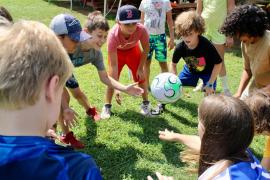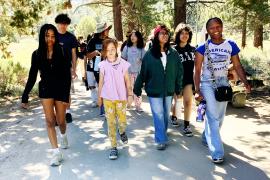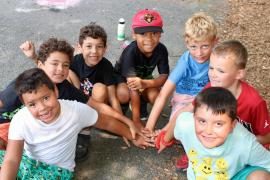Without a plan, we do not know where we are going. Four years ago I was sitting in a meeting with all of our camp department heads, talking about developing themes and character for the facility. Someone mentioned that it was important to consider our natural environment. That was all it took to start— the seed had been planted. From there we brainstormed a short list of ideas to minimize waste, and within three months we had our first draft of a Waste Reduction Plan. The following year our focus expanded and the Environmental Stewardship Plan was born.
In the camp industry, we are familiar with planning for program and facility. Chances are that your camp has a mission, a philosophy and related goals, a budget, an operating plan, a marketing plan, a strategic plan, and maybe even a master plan. In order to make a serious commitment in responsibility for the environment, your camp needs to develop an Environmental Stewardship Plan.
Start by finding a champion—a staff member or volunteer to cultivate and manage the plan. The champion does not create the plan—the ideas should come from each department and area of your camp and program. Everyone is a part of it. For our plan, we asked all staff to come up with at least three things that their own department could do to reduce waste and started with their ideas. The Stewardship Plan changed the culture of camp. We are proud of what we have done so far and excited about the many things we are looking forward to changing. What follows are the essential elements that we used to develop a successful Environmental Stewardship Plan. These elements may work for your camp/program:
Strategy
Develop a strategy to implement practices throughout the facility/program that reduce consumption of natural resources, minimize production of waste materials, and promote sustainable environmental stewardship.
Key Features
To help your plan take root and be successful:
- Identify an environmental stewardship champion.
- Have all departments involved in setting up systems and implementing the plan.
- Make everyone responsible for bringing new information, technology, and ideas to the group.
- Develop the plan on a continual basis and update it at least once every year.
- Educate staff and participants about stewardship practices, including ideas on how to implement similar practices at home.
- Create a culture that values and is committed to waste reduction and environmental stewardship.
Identify Goals
Organize your own ideas into categories that make sense and set a goal for each category. Here are some examples that we started with:
- Recycling
Goal: Have user-friendly systems for guests and staff to be able to maximize the amount and variety of materials recycled. Utilize the state’s redemption value of materials to subsidize any waste reduction costs. - Water Conservation
Goal: Utilize low-flow technology on showers, toilets, spray nozzles, etc. Use composting toilets and alternative wastewater systems to minimize water usage and utilize grey water. Work with Navy to restore wetlands. Reduce water use and reuse water where possible. - Energy Conservation
Goal: Implement alternative energy technology such as photovoltaic (solar), wind, and passive heating. Minimize energy use with low-energy lights, appliances, timers, clean equipment, and thermostats. Monitor energy use and develop practices to minimize consumption. - Compost
Goal: Utilize and interpret a system for composting (kitchen prep and guest food waste) to connect food production, transport, consumption, and waste with the environment.
After a couple of years we added:
- Purchasing
Goal: Explore purchasing options and show preference towards the purchase and utilization of environmentally friendly products. When building or replacing facilities, re-use materials or purchase recycled, non-toxic, recyclable, and sustainable products wherever feasible. Other factors such as carbon footprints, product certification (organic, FSC, Fair Trade, etc.), and environmental and social justice issues should be researched and considered. - Facility Development
Goal: Consider structural design and orientation to maximize energy efficiency and preservation of habitat. Reuse materials or use sustainable materials where possible.
Clarify Responsibilities
Work together to agree on tasks. Involve everyone as much as possible. For example, this is a potential department list under Energy Conservation:
General Camp Areas
- Place signs near all light switches to remind people to turn off lights when not in use.
- Use timers for common areas and adjust times monthly to align with season.
- Turn off nonsecurity night lighting when camp is not in use.
- Find cabin heaters that are safe and energy efficient.
Kitchen
- Check refrigerator and freezer temperatures daily and keep adjusted at correct temperatures.
- Store food in refrigerators and freezer to allow for air circulation.
- Make sure that food warmers and ovens are turned off when not needed.
Maintenance
- Use long-life and energy efficient light bulbs in all camp areas.
- Integrate alternative energy (i.e., solar) into the camp energy grid.
- Use solar path lighting where feasible.
- Existing windows will be replaced with double pane windows as needed.
Offices
- Turn off office lights when not in use.
- Use air conditioners only when necessary for equipment.
- Turn off computers and monitors at night.
Program
- Turn off heaters and lights in quad rooms, MPR, and cabins when not in use.
- Educate guests to turn cabin heaters on at dinner and off at breakfast when in use.
- All laundry will be full loads and use cold temperatures when possible.
- Aquarium chiller monitored and cleaned for optimal performance.
- Bait freezer defrosted as needed.
- Sound equipment turned off when not in use.
Store
- Ice cream freezers to be emptied and unplugged during the off-season.
- Soda refrigerator to be unplugged during off-season.
Celebrate! Interpret and Recognize Success
Share with your staff and guests what changes you have made and why. Be the example of stewardship for others and give them ideas of what they can do at home. Give them information about how stewardship makes a difference! The statistics below offer examples of that impact.
How we make a difference every day…
Aluminum
- One recycled aluminum can saves enough electricity to operate a TV for three hours.
- For every twenty-two aluminum cans we recycle, we save the equivalent in energy of one gallon of gasoline.
- Recycling aluminum results in 95 percent less air pollution, 97 percent less water pollution, and 95 percent less energy being used than producing aluminum from virgin resources.
- Sixty-five percent of aluminum containers in the U.S. are recycled, yet more than 1 million tons of aluminum cans are thrown away each year.
Wood Products
- When you purchase wood and wood products, you can make a choice to purchase wood that has been harvested in a way that does not negatively affect the health of the forest or wildlife habitat.
- Forest Stewardship Council (FSC) certified wood and wood products have been harvested from forests that meet third-party criteria to ensure responsible and sustainable forest management.
- You can track any FSC certified lumber or wood product chain of custody back to the forest where it came from to insure that it came from legal and wellmanaged sources.
References
I Love a Clean San Diego, Center for Redefining Progress, Forest Stewardship Council.
If you would like to have a worksheet to develop your plan or a complete copy of YMCA Camp Surf ’s current Environmental Stewardship Plan, contact Zayanne Thompson at[email protected].
Originally published in the 2007 November/December issue of Camping Magazine.




